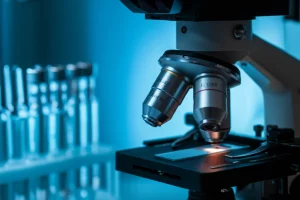When the Newborn Screen Says ‘All Clear’: Brain Imaging and Hidden GA-I
Hey there! Let’s chat about something super important, something that shows us that even with all our fancy modern medicine, sometimes the old-school detective work is still absolutely crucial. I’m talking about diagnosing a tricky condition called Glutaric Aciduria type I (GA-I), especially when the standard newborn screening test, which is usually a superhero, somehow misses the mark.
What Exactly is GA-I, Anyway?
So, imagine your body is a complex factory, and it needs to break down certain building blocks from food, like specific amino acids (lysine, hydroxylysine, and tryptophan). GA-I is like having a faulty machine in that factory – specifically, the enzyme called glutaryl-CoA dehydrogenase (GCDH) isn’t working right. When this machine is broken, waste products, like glutaric acid and 3-hydroxy glutaric acid, build up. And trust me, you don’t want these building up, especially in a developing brain.
Often, kids with GA-I start showing serious problems, usually between 3 and 36 months old. We’re talking about severe, irreversible movement issues – things like stiff muscles (dystonia) on top of floppy muscles (hypotonia). These symptoms can come on suddenly, often triggered by something simple like a fever or a common cold, leading to what we call an encephalopathic crisis. It’s a really tough situation, and sadly, it can have high morbidity and mortality. Some kids, though, have a more gradual onset without a big crisis.
Looking Inside: What the Brain Scans Tell Us
This is where things get really interesting, and frankly, a bit of a lifesaver when other tests are confusing. When we look at the brain of a child with GA-I using an MRI (Magnetic Resonance Imaging), we often see tell-tale signs. The most striking finding is damage to the basal ganglia, particularly areas called the putamina. Think of the basal ganglia as the brain’s movement control center. When it’s damaged, you get those severe movement problems I mentioned.
Why does this damage happen? Well, it seems to be related to the energy crisis caused by the build-up of those waste products. The brain cells, especially in the basal ganglia, just can’t get enough energy, leading to swelling and damage. On MRI, we see specific signal changes in these areas. Sometimes, proton MR spectroscopy can also show changes, like a bit of lactate during a crisis. Other findings might include shrinking (atrophy) or underdevelopment (hypoplasia) in the front parts of the brain, delayed myelination (the insulation around nerve fibers), and sometimes even bleeding around the brain or in the eyes. Oh, and about 75% of patients have a larger-than-average head size (macrocephaly) from birth or early infancy.
The Usual Suspects: How We Test for It
Traditionally, diagnosing GA-I involves looking for those specific waste products. We check for glutaric acid (GA) and 3-hydroxy glutaric acid (3-HGA) in the urine, and a related substance called glutarylcarnitine (C5DC) in the blood.
Now, here’s a wrinkle: not all patients show the same level of these substances. We have “High Excretors” (HE) who have lots of GA and 3-HGA in their urine. But then there are “Low Excretors” (LE), who make up a significant chunk, maybe up to 40%. These LE folks have much lower, sometimes even *absent*, GA in their urine, only slightly elevated 3-HGA, and potentially normal C5DC levels. See why they can be tricky? Their biochemical “fingerprint” is much fainter.
The Safety Net… Sometimes It Has Holes
Because C5DC can be picked up in a tiny spot of dried blood (a dried blood spot, or DBS) using a technique called tandem mass spectrometry (MS/MS), GA-I has been added to newborn screening programs in many places, including parts of the US and Europe. This is fantastic because catching GA-I early, *before* symptoms start, means we can often prevent or significantly reduce that devastating brain damage with diet and supplements.
However, and this is a big “however,” newborn screening isn’t foolproof, especially for those tricky LE patients. If their C5DC levels are too low or normal, the screen might just say “everything looks fine,” and the condition goes undetected.

Our Story: A Case That Opened My Eyes
Let me tell you about a specific case that really highlights this challenge. We had a little patient, nine months old, whose newborn screen had come back completely normal. He was doing great in his first few months, hitting all his milestones. But then, he got a common upper airway infection with a fever and wasn’t eating well. Suddenly, things took a turn. He started having persistent tonic seizures and became less responsive. This sent him straight to the intensive care unit.
Basic tests for infections and common metabolic problems were all normal – no acidosis, no high ammonia, normal glucose and lactate. But when we did a brain MRI… bam. There were those unmistakable bilateral signal alterations in the basal ganglia, affecting the caudate, putamen, and pallidum. This picture immediately screamed “something is wrong in the movement control area!”
The Biochemical Puzzle That Didn’t Fit
Given the scary MRI findings, we did a deep dive into metabolic tests. And guess what? His plasma amino acids were normal. His DBS acylcarnitine profile, including C5DC, was *normal*. His urinary organic acids showed only a *slight* bump in 3-HGA and *no* detectable glutaric acid. Even checking urinary C5DC, which is sometimes elevated in LE patients, came back normal, even after giving him carnitine supplements.
So, here we had a child with classic, severe neurological symptoms and typical GA-I brain imaging, but biochemical tests that were essentially normal, just like his newborn screen. It was a real head-scratcher if you were *only* looking at the numbers.
Connecting the Dots: Imaging Points the Way
This is where clinical suspicion, driven heavily by those suggestive neuroradiological findings, became paramount. Despite the “normal” biochemical picture, the brain MRI was screaming GA-I. We suspected he was one of those tricky LE patients. The only way to be sure was genetic testing.
And turns out, our suspicion was correct! Molecular analysis of the GCDH gene confirmed the diagnosis. He had a specific variant, homozygous p.M405V. This variant is particularly interesting because it’s quite common in people of African origin and is known to be associated with that low-excretor phenotype – meaning, the enzyme still works a little bit (around 8-35% of normal), enough that the waste products don’t build up to super high levels, but *not* enough to prevent the devastating neurological damage, especially during times of stress like an illness.
This variant has been seen in other LE patients, some of whom were also missed by newborn screening and presented later with symptoms and basal ganglia involvement on MRI, just like our patient.
Lessons Learned from Missed Cases
Our case isn’t unique, unfortunately. There have been other reports of GA-I patients missed by NBS, often those with the LE phenotype and certain genetic variants like M405V. These kids often present later, usually after an acute illness, with those severe neurological crises and the characteristic basal ganglia damage on MRI.
Interestingly, many of these missed LE patients, including ours, didn’t have the macrocephaly (large head) that’s often associated with GA-I. And while they all showed basal ganglia involvement on imaging, they sometimes lacked other typical GA-I neuroradiological signs like widening of brain spaces or frontal atrophy.
What seems to be a consistent finding in many of these missed LE cases is at least a *slight* elevation of urinary 3-HGA, even if GA and C5DC are normal. This reinforces the idea that 3-HGA is a really important biomarker to check.
So, what’s the big picture here? Even though NBS for GA-I is generally effective, it has limitations, particularly for the LE phenotype. These patients can have normal C5DC in DBS and normal urinary GA. They might not look biochemically “sick” until they have a crisis. When that happens, the brain imaging is often the loudest clue, pointing towards GA-I even when the biochemical tests are quiet.
The diagnosis is ultimately confirmed by looking at the genes. Given the prevalence of certain LE-associated variants like M405V in specific populations (like those of African origin) and increasing global movement, it’s vital for doctors to keep GA-I in mind if they see a child with suggestive neurological symptoms and those characteristic basal ganglia changes on MRI, *even if* their newborn screen was negative and their standard biochemical tests aren’t screaming GA or C5DC.
We need to maintain a high degree of vigilance. A negative newborn screen and normal typical biochemical markers don’t necessarily rule out GA-I, especially when the clinical picture and the brain imaging are telling a different story.
Source: Springer







